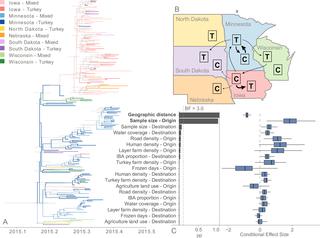当前位置:
X-MOL 学术
›
PLOS Pathog.
›
论文详情
Our official English website, www.x-mol.net, welcomes your
feedback! (Note: you will need to create a separate account there.)
Agricultural and geographic factors shaped the North American 2015 highly pathogenic avian influenza H5N2 outbreak.
PLoS Pathogens ( IF 5.5 ) Pub Date : 2020-01-21 , DOI: 10.1371/journal.ppat.1007857 Joseph T Hicks 1 , Dong-Hun Lee 2 , Venkata R Duvvuri 1 , Mia Kim Torchetti 3 , David E Swayne 4 , Justin Bahl 1, 5
PLoS Pathogens ( IF 5.5 ) Pub Date : 2020-01-21 , DOI: 10.1371/journal.ppat.1007857 Joseph T Hicks 1 , Dong-Hun Lee 2 , Venkata R Duvvuri 1 , Mia Kim Torchetti 3 , David E Swayne 4 , Justin Bahl 1, 5
Affiliation

|
The 2014-2015 highly pathogenic avian influenza (HPAI) H5NX outbreak represents the largest and most expensive HPAI outbreak in the United States to date. Despite extensive traditional and molecular epidemiological studies, factors associated with the spread of HPAI among midwestern poultry premises remain unclear. To better understand the dynamics of this outbreak, 182 full genome HPAI H5N2 sequences isolated from commercial layer chicken and turkey production premises were analyzed using evolutionary models able to accommodate epidemiological and geographic information. Epidemiological compartmental models embedded in a phylogenetic framework provided evidence that poultry type acted as a barrier to the transmission of virus among midwestern poultry farms. Furthermore, after initial introduction, the propagation of HPAI cases was self-sustainable within the commercial poultry industries. Discrete trait diffusion models indicated that within state viral transitions occurred more frequently than inter-state transitions. Distance and sample size were very strongly supported as associated with viral transition between county groups (Bayes Factor > 30.0). Together these findings indicate that the different types of midwestern poultry industries were not a single homogenous population, but rather, the outbreak was shaped by poultry industries and geographic factors.
中文翻译:

农业和地理因素导致了2015年北美高致病性禽流感H5N2的爆发。
2014-2015 年高致病性禽流感 (HPAI) H5NX 疫情是美国迄今为止规模最大、损失最惨重的 HPAI 疫情。尽管进行了广泛的传统和分子流行病学研究,但与中西部家禽养殖场中 HPAI 传播相关的因素仍不清楚。为了更好地了解此次疫情的动态,使用能够适应流行病学和地理信息的进化模型对从商业蛋鸡和火鸡生产场所分离的 182 个全基因组 HPAI H5N2 序列进行了分析。嵌入系统发育框架的流行病学分区模型提供了证据,证明家禽类型是中西部家禽养殖场中病毒传播的屏障。此外,在最初引入后,高致病性禽流感病例的传播在商业家禽业中可以自我维持。离散性状扩散模型表明,州内病毒性转变比州间转变更频繁地发生。距离和样本量与县组之间的病毒性转变相关(贝叶斯因子> 30.0)得到了非常强烈的支持。这些发现共同表明,中西部不同类型的家禽业并不是单一的同质群体,而是由家禽业和地理因素决定了疫情的爆发。
更新日期:2020-01-22
中文翻译:

农业和地理因素导致了2015年北美高致病性禽流感H5N2的爆发。
2014-2015 年高致病性禽流感 (HPAI) H5NX 疫情是美国迄今为止规模最大、损失最惨重的 HPAI 疫情。尽管进行了广泛的传统和分子流行病学研究,但与中西部家禽养殖场中 HPAI 传播相关的因素仍不清楚。为了更好地了解此次疫情的动态,使用能够适应流行病学和地理信息的进化模型对从商业蛋鸡和火鸡生产场所分离的 182 个全基因组 HPAI H5N2 序列进行了分析。嵌入系统发育框架的流行病学分区模型提供了证据,证明家禽类型是中西部家禽养殖场中病毒传播的屏障。此外,在最初引入后,高致病性禽流感病例的传播在商业家禽业中可以自我维持。离散性状扩散模型表明,州内病毒性转变比州间转变更频繁地发生。距离和样本量与县组之间的病毒性转变相关(贝叶斯因子> 30.0)得到了非常强烈的支持。这些发现共同表明,中西部不同类型的家禽业并不是单一的同质群体,而是由家禽业和地理因素决定了疫情的爆发。











































 京公网安备 11010802027423号
京公网安备 11010802027423号